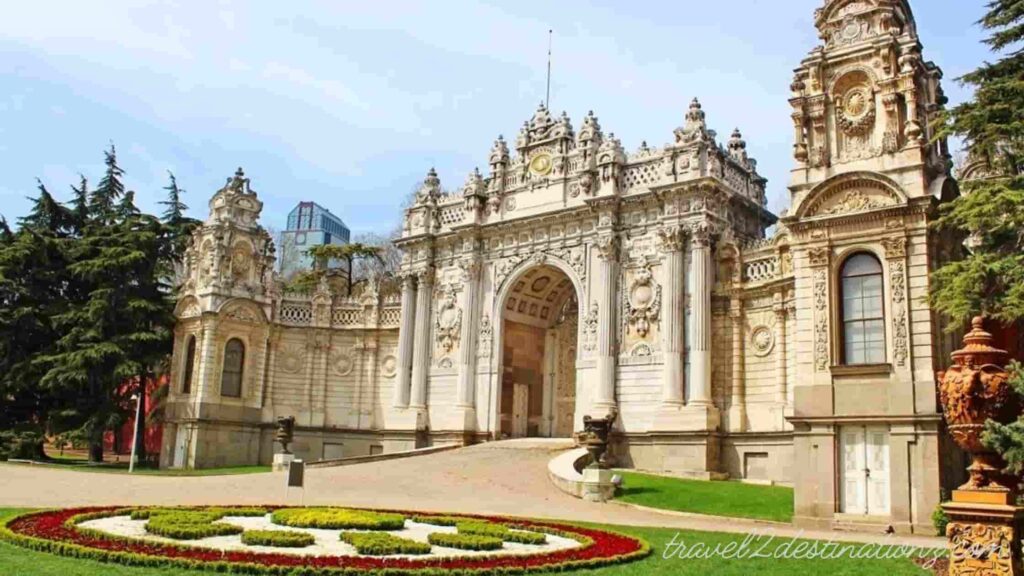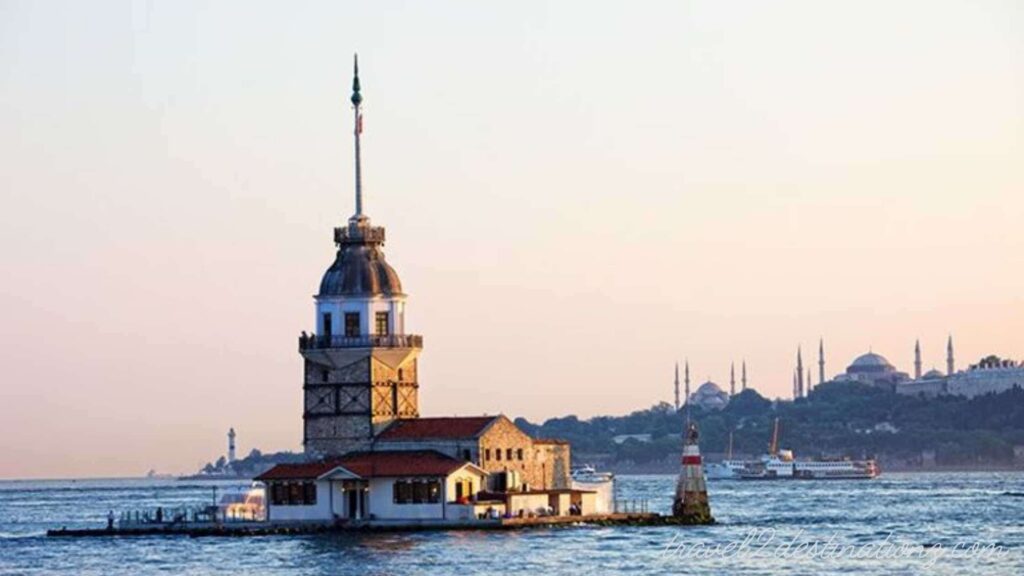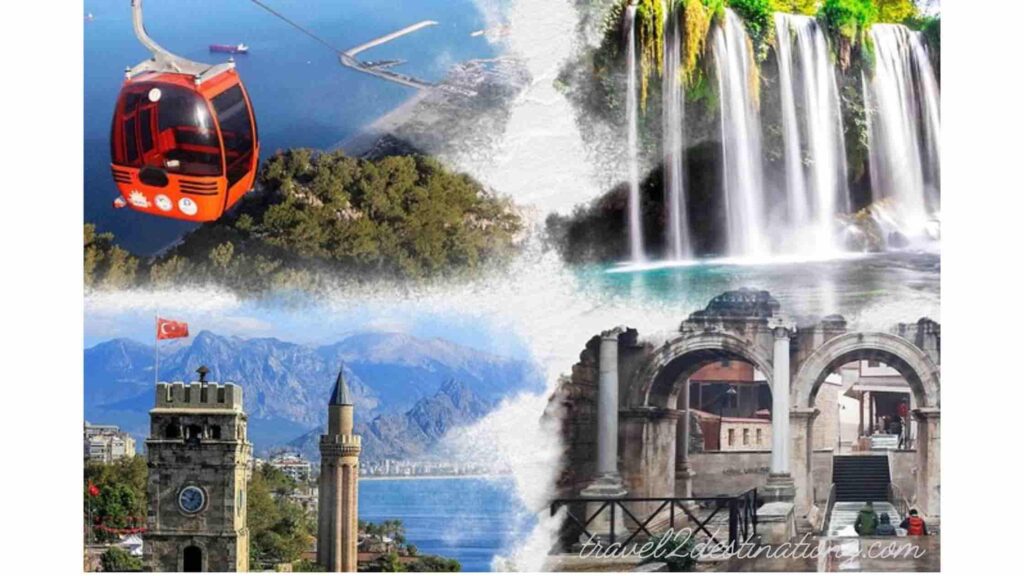Explore Iconic Turkey Landmarks with a Complete Guide & Help
Embark on an enchanting journey through Turkey for the masterpieces of Turkey Landmarks, a land where history whispers through its ancient ruins, and breathtaking landscapes paint a mesmerizing panorama. Explore the iconic minarets of Istanbul, the surreal fairy chimneys of Cappadocia, and the azure shores of Antalya. From the majestic Mount Ararat to the hidden wonders of underground cities.
Almost 50 Turkey landmarks are waiting to be discovered. Immerse yourself in Ottoman splendor, wander through ancient mosques, and traverse lush green valleys. Whether you are in search of spiritual solace or thrilling adventures, Turkey is full of its rich heritage and warm hospitality, promising an adventure beyond compare.
Turkey Landmarks Attractions
With its unlimited wealth of historical sites, breathtaking natural wonders, and vibrant dual-continent culture, Turkey is a destination that truly gives peace and where imaginations come true.
Whether you’re a history lover, an adventure freak, or simply looking to get lost in the beauty of diverse landscapes, Turkey landmarks have something special for every traveler.
Plan your journey today and prepare to be enchanted by the giants of Turkey. Here are some famous landmarks in Turkey that your eyes want to see.
Hagia Sophia
Hagia Sofia in the beautiful city of Istanbul, is said to be the most significant among Turkey Landmarks. Hagia Sophia was built in 537 AD standing as a testament to Byzantine architectural prowess, In May 1453, the Ottoman forces conquered Constantinople, and the church was converted into the Hagia Sophia Mosque.

Hagia Sophia attracts visitors with its grand dome and intricate mosaics. Originally built as a cathedral, it later transformed into a mosque and now serves as a museum, symbolizing the convergence of cultures in Istanbul.
Turkey Landmarks Travel Ideas: History buff? Combine iconic landmarks like Hagia Sophia, and Blue Mosque with ancient wonders like Ephesus for a Turkish odyssey.
Blue Mosque (Sultan Ahmed Mosque)
Shining with its distinctive blue tiles, the Blue Mosque mesmerizes with its elegant minarets and spacious courtyard. It was constructed between 1609 and 1617 during the era of Ahmed I and remains a functioning mosque today.

It also attracts many tourists and is one of the most iconic and popular monuments of Ottoman architecture. It remains a symbol of Istanbul’s spiritual and cultural significance.
Want to go on Vacation Here are some packing tricks for you: Tropical Vacation Packing List
Topkapi Palace
Construction was ordered by Sultan Mehmed the Conqueror and began in 1459, six years after the conquest of Constantinople. Topkapı was originally called the “New Palace” to distinguish it from the Old Palace.

The lavish residence of Ottoman sultans, Topkapi Palace exudes luxuriousness and grandeur. Visitors can wander through its ornate chambers, lush gardens, and treasure-filled exhibits, gaining insight into the splendor of Turkey’s imperial past.
Destination Alert: Best Hikes in Sedona
Cappadocia (Göreme National Park and the Rock Formations)
Cappadocia unveils a surreal landscape with fairy chimneys, cave dwellings, and ancient churches carved into the soft volcanic rock. Fairy chimneys are uniquely shaped earth pillars of natural wonders formed in pyroclastic deposits consisting of thick units of tuffs, volcanic ashes, and ignimbrites.

Goreme is a small village set among ‘fairy chimney’ rock formations in the historical region of Cappadocia. Göreme National Park is a UNESCO World Heritage Site, offering panoramic vistas and thrilling hot air balloon rides at sunrise.
Hot Air Balloon Rides Cappadocia
Cappadocia offers a wide range of activities, but among them, hot air balloon rides are truly unique.

You can experience the stunning landscapes of Cappadocia from a bird’s-eye view while drifting high above the rocky terrain in a colorful balloon basket. This experience will create lasting memories that you’ll cherish forever.
Ephesus
Ephesus was a city in Ancient Greece on the coast of Ionia, 3 kilometers southwest of present-day Selçuk in İzmir Province. It was built in the 10th century BC. Stepping back in time, Ephesus emerges as an archaeological marvel, offering well-preserved ruins of an ancient Greek city. The city was famous in its day for the Temple of Artemis (completed around 550 BC).

Highlights include the majestic Library of Celsus, the Grand Theater, and the Temple of Artemis, one of the Seven Wonders of the Ancient World.
Pamukkale
Pamukkale is one of the majestic Turkey landmarks known as the “Cotton Castle,” Pamukkale is a charming terraces of travertine pools, formed by mineral-rich thermal waters cascading down the hillside.

It is located in Turkey’s Inner Aegean region, in the River Menderes valley, which has a clement climate for most of the year. Visitors can dive in the rejuvenating pools with stunning landscapes.
Destination Alert: Top 5 Tourist Attractions in Maldives
Mount Nemrut
Mount Nemrut or Nemrud mountain in southeastern Turkey, is known for the summit where several large statues are erected around what is assumed to be a royal tomb from the 1st century BC.

Summit of Mount Nemrut unveils a monumental sanctuary built by King Antiochus I of Commagene. Giant statues of gods and kings overlook the horizon, offering a glimpse into ancient rituals and beliefs.
Ani
Ani is a ruined medieval Armenian city now situated in Turkey’s province of Kars, next to the closed border with Armenia.

Famous as the “City of 1001 Churches,” Ani once thrived as a medieval Armenian capital between 961 and 1045 along the Silk Road. Today, its scary ruins stand as a testament to its former glory, inviting visitors to explore its deserted streets and ornate churches.
Sumela Monastery
Located within the Pontic Mountains, in the Maçka district of Trabzon Province in modern Turkey. Settled on a sheer cliff of about 1,200 meters face in the middle of lush forests, Sumela Monastery evokes a sense of serenity and spirituality. It was founded around 386 AD, during the reign of the emperor Theodosius I.

Dating back to the Byzantine era, this architecture is adorned with frescoes depicting religious scenes and mythical pictures.
Destination Alert: Most Expensive Hotels in Chicago
Gallipoli Peninsula
Gallipoli Peninsula is located in the southern part of East Thrace, the European part of Turkey, with the Aegean Sea to the west.

At the shores of the Dardanelles, the Gallipoli Peninsula stands as a reminder of the sacrifices made during World War I. Visitors pay tribute to the fallen soldiers at numerous memorials and cemeteries, reflecting on the enduring legacy of courage and camaraderie.
The Grand Bazaar in Istanbul
Reward yourself with the vibrant colors of Turkey’s Landmarks, the scents, and sounds at the Grand Bazaar, one of the world’s oldest and biggest covered markets with 61 streets and almost 4000 shops. The construction of the Grand Bazaar started during the winter of 1455/56.

Lose yourself in narrow alleys filled with treasures ranging from hand-woven carpets and exquisite ceramics to jewelry, aromatic spices, and delicious food.
The Spice Bazaar in Istanbul
On a journey at the Spice Bazaar, where the air is drugged with the intoxicating aroma of exotic spices, teas, and Turkish delights. It is the most famous covered shopping complex after the Grand Bazaar.

Spice Bazaar has a total of 85 shops selling spices, Turkish delights, and other sweets, jewelry, souvenirs, and dried fruits and nuts. Treat yourself to the vibrant displays of saffron, sumac, and cumin, while savoring the hustle and bustle of Istanbul’s culinary heart.
Dolmabahçe Palace
Elegance and extravagance converge at Dolmabahçe Palace, a masterpiece of Ottoman architecture nestled along the shores of the Bosphorus. Marvel at its glittering chandeliers, intricate woodwork, and opulent furnishings as you explore the halls that once hosted sultans and dignitaries from around the world.

Maiden’s Tower (Kız Kulesi)
Shrouded in myth and legend, the Maiden’s Tower also known as Leander’s Tower emerged from the waters of the Bosphorus since the Byzantine period, casting a spellbinding silhouette against the Istanbul skyline. In 1110 Byzantine emperor Alexius Comnenus built a wooden tower protected by a stone wall. The tower was destroyed during the earthquake of 1509, rebuilt, and then burned down in 1721.

The tower appeared on the back of the Turkish 10 Lira banknote from 1966 to 1981 Legend has it that a maiden was imprisoned within its walls, giving rise to tales of forbidden love and tragic fate.
Galata Tower
The Galata Tower built in 1348 now the Galata Tower Museum is an old Genoese tower in the Galata part of the Beyoğlu district of Istanbul, Turkey. Built as a watchtower at the highest point of the Walls of Galata,

The Galata Tower offers panoramic views of Istanbul’s sprawling cityscape and shiny waterways. It has become an iconic city symbol, inviting visitors to ascend its heights and savor the enchanting views around.
Troy
Troy was an ancient city located in present-day Hisarlik, Troy was repeatedly destroyed and rebuilt during its four thousand years of occupation.

Diving through time at the ancient city, immortalized in Homer’s epic poem, the Iliad. These ruins were added to the UNESCO World Heritage Site list in 1998, where the legendary Trojan War unfolded, and discover the layers of history hidden beneath its soil.
Bodrum Castle – Famous Landmark in Turkey
Standing on the shores of the Aegean Sea, Bodrum Castle stands as a formidable fortress against the backdrop of sparkling waters and sun-kissed beaches. Explore its imposing ramparts, medieval towers, and underwater archaeology museum, where artifacts from ancient shipwrecks are displayed.

Mount Ararat
Rising majestically on the eastern horizon is a snow-capped and inactive compound volcano. It consists of two major volcanic cones Greater Ararat and Little Ararat.

Mount Ararat commands awe and reverence as Turkey’s highest peak and legendary resting place of Noah’s Ark. Whether trekking through its rugged slopes or gazing in wonder from afar, Mount Ararat leaves an indelible mark on the landscape and the imagination.
Süleymaniye Mosque
A masterpiece of Ottoman architecture was built in 1550 and inaugurated in 1557, Süleymaniye Mosque dominates the Istanbul skyline with its imposing domes and beautiful minarets. The Süleymaniye was damaged in the great fire of 1660 and was restored by Sultan Mehmed IV. Part of the dome collapsed during the earthquake of 1766.

Enter its serene courtyard and marvel at the spiritual blend of Islamic art and architectural grandeur, paying tribute to the legacy of its visionary creator, Sultan Suleiman the Magnificent.
Derinkuyu Underground City
Delve into the depths of Cappadocia’s mysteries at Derinkuyu Underground City, also known as Elengubu, a widespread subterranean puzzle carved into the soft volcanic rock.

Explore its complex network of tunnels, chambers, and dwellings, marveling at the ingenuity of its ancient inhabitants who sought refuge from invaders and harsh climates.
Lake Van
Embark on a tranquil escape to the serene shores of Lake Van, Turkey’s largest lake nestled in the middle of dramatic mountain scenery.

Cruise its shimmering waters, explore its historic islands, or relax on its pristine beaches, soaking in the beauty and calmness of this natural gem.
Turkey Antalya Attractions
Antalya is the fifth-most populous city in Turkey and the Capital of Antalya Province. Recognized as the “Capital of tourism” in Turkey and a pivotal part of the Turkish Riviera, Antalya is on Anatolia’s southwest coast, surrounded by the Taurus Mountains.

Get ready for an unforgettable journey filled with natural wonders, historical sites, and vibrant culture.
Antalya is renowned for its stunning coastline, ancient ruins, and picturesque landscapes, making it a must-visit destination for travelers.
Antalya Old Town (Kaleiçi)
Step back in time as you wander through the narrow streets of Antalya’s charming Old Town. Praise the Ottoman-era architecture, visit historic landmarks like the Hadrian’s Gate and the Clock Tower, and explore the quaint shops and cafes within the ancient walls.
Aspendos
Aspendos or Aspendus was an ancient Greco-Roman city in Antalya province of Turkey. The site is located 40 km east of the modern city of Antalya. It was situated on the Eurymedon River about 16 km inland from the Mediterranean Sea. It shared a border with, and was hostile to, the ancient city of Side.
Step into the spotlight of antiquity at Aspendos, home to one of the best ancient theaters in the world. Marvel at its flawless acoustics and superb architecture as you imagine the spectacle of gladiator battles and theatrical performances that once graced its stage.
Duden Waterfalls
Escape the hustle and bustle of the city and indulge yourself in the natural beauty of Duden Waterfalls. Located just a short drive from Antalya, these cascading waterfalls are a serene oasis where you can relax, picnic, and enjoy stunning views of the surrounding landscape.
Konyaalti Beach
Soak up the sun and sea at Konyaalti Beach, one of Antalya’s most popular and most visited stretches of coastline. Whether you’re lounging on the sandy shores, swimming in the turquoise waters, or enjoying water sports like jet-skiing and parasailing, this beach has something special for everyone to enjoy.
Termessos
Let’s go on a journey to the ancient city of Termessos, perched high in the Taurus Mountains. Explore the preserved ruins of this once-thriving city, including its temples, agora, and theater, and soak in the breathtaking views of the surrounding wild landscape.
Antalya Aquarium
Dive into the wonders of the deep Antalya Aquarium, one of the largest aquariums in the world. With its huge collection of marine life, interactive exhibits, and underwater tunnel, this family-friendly attraction offers a world beneath the waves.
Olympos Teleferik
Soar to new heights aboard the Olympos Teleferik, a cable car with breathtaking views of the mountains and coastline. Whether you’re a nature lover, a thrill-seeker, or simply looking for panoramic vistas, this scenic ride will take your breath away.
Explore Landmarks in Europe
Why is Turkey’s Location Important
Turkey, a nation holding the continents of Europe and Asia, offers a rich history, culture, and breathtaking natural beauty. But beyond its captivating Turkey landmarks like Hagia Sophia, Ephesus, and Mount Nemrut, lies another facet that fuels Turkey’s significance: its strategic location.
A Crossroads of Continents
Turkey is a land bridge connecting Europe’s bustling metropolises to Asia’s ancient wonders. That’s precisely where Turkey finds itself. This privileged position has placed it at the heart of trade routes for centuries, facilitating the exchange of goods, ideas, and cultures.
From the famous Silk Road that snaked its way through Anatolia to modern-day shipping routes, Turkey has always been a vital commercial link in the region.
Gateway to the Middle East
Turkey’s eastern borders are seamlessly connected to the Middle Eastern landscapes.
This geographical connection encourages political and economic ties with its neighbors. Turkey is a bridge for diplomacy and trade, fostering dialogue and understanding between the Middle East and Europe.
Guarding the Strategic Straits
Turkey has coastlines bordering the Black Sea and the Mediterranean. Here’s where things get geopolitically interesting and valuable. Turkey has control over crucial straits like the Bosphorus and Dardanelles, which connect the Black Sea to the Mediterranean.
These vital waterways serve as major shipping lanes for global trade, making Turkey a major player in maritime affairs.
A Land of Rich Resources
Besides its historical and cultural treasures, Turkey is blessed with natural resources.
From fertile agricultural plains to mineral deposits and access to oil and gas reserves, Turkey’s diverse landscape supports its economy and strategic importance.
Why does Turkey have Land in Europe?
Turkey is a transcontinental country, with its landmass in Europe and Asia. The division between the two continents is primarily geographical and is marked by the Bosporus Strait, the Sea of Marmara, and the Dardanelles.
These waterways separate the European part of Turkey, East Thrace, from its Asian part, Anatolia. The European portion of Turkey is smaller in size, Istanbul is in Europe which is significant both historically and culturally.
Transportation Means to Visit Turkey Landmarks
Turkey, a treasure of historical landmarks and captivating natural beauty, welcomes travelers from all corners of the globe. Here’s a comprehensive guide to exploring Turkey landmarks using various transport options:
Visit Turkey Landmarks by Public Transportation
Turkish cities offer well-developed public transportation networks, making them easy to navigate. Major cities like Istanbul, Ankara, and Izmir offer extensive bus routes, trams, subways, and even nostalgic funiculars that climb steep hills.
These affordable options allow you to hop on and off, wandering in the urban sights and ensuring easy access to historical landmarks like Topkapi Palace or the Grand Bazaar.
Visit Turkey Landmarks by Buses and Dolmuşes
Turkey’s intercity bus network is a marvel of efficiency and service quality. Long-distance bus service connects major cities, country-sides, and villages, offering a comfortable and budget-friendly source of travel.
For shorter distances, consider the ubiquitous dolmuş ( minibus) or a shared taxi system that follows designated routes. These vibrant vehicles, often overflowing with local charm, provide a glimpse into Turkish daily life while shuttling you between historical gems like Ephesus or the ancient city of Aspendos.
Visit Turkey Landmarks by Train
For a more scenic journey, consider the Turkish railway network. High-speed trains connect major cities, offering a comfortable and time-saving option.
Traditional intercity trains, while slower, trespass through the countryside, opening breathtaking landscapes and hidden historical sites. Imagine passing through rolling hills filled with Ottoman ruins or witnessing the majestic Taurus Mountains on your way to Turkey landmarks like Mount Nemrut or the captivating city of Sanliurfa.
Visit Turkey Landmarks on Domestic Flights
Turkey’s domestic flight network allows you to travel vast distances efficiently. Affordable, quick flights connect major cities and coastal destinations, making it possible to explore a wider range of Turkey landmarks in a shorter time.
Visit Turkey Landmarks with Car Rentals
For the ultimate flexibility, renting a car is a perfect option. This option allows you to explore difficult Turkey landmarks and hidden gems at your own pace.
Cruise along the wonderful Mediterranean coast, stopping at charming coastal towns and historical ruins that pique your interest. Remember, driving in busy cities might be challenging, so this option is best suited for exploring the scenic countryside and venturing beyond the major landmarks.
Summary of Turkey Landmarks
Turkey is a land full of historical significance, natural beauty, hospitality, and cultural intrigue. Turkish cuisines are considered to be amongst the most delicious.
From the awe-inspiring ruins of Ephesus and Troy to the otherworldly landscape of Cappadocia and the majestic peak of Mount Ararat, Turkey caters to travelers with a variety of interests. This captivating country, positioned at the crossroads of Europe and Asia, offers an unforgettable journey for those seeking to explore ancient civilizations, delve into rich cultural traditions, and marvel at breathtaking natural wonders and Turkey landmarks.
FAQ’s About Turkey Landmarks
What is the main monument in Turkey?
The Hagia Sophia also called Ayasofya is the symbol of Istanbul. It was built during the reign of Justinian between 532 and 537 and is a masterpiece of Byzantine art.
What is the most visited place in Turkey?
Istanbul is the most visited Turkish city by foreign tourists.
Antalya is the fifth most populous city in the country.
Izmir is home to around 4.5 million people.
Bodrum was once home to one of the Seven Wonders of the Ancient World.
Hagia Sophia and Blue Mosque are also the most visited Turkey Landmarks.
Where is Turkey located?
Turkey is situated at the crossroads of the Balkans, Caucasus, Middle East, and eastern Mediterranean.
Is Turkey part of Asia or Europe?
Turkey is located in Southeastern Europe and Southwestern Asia. European (or Balkan) Turkey is relatively small compared to the Asian part, the Anatolian Plateau, which is a large peninsula. That’s why Muslims are in the majority.
Why do tourists love Turkey?
With its warm hospitality, diverse experiences, and a taste of both Europe and Asia, Turkey beckons tourists from all over the world to explore its captivating charm.

One Comment